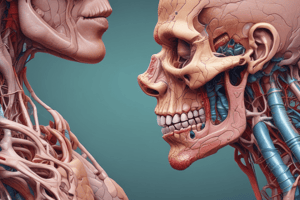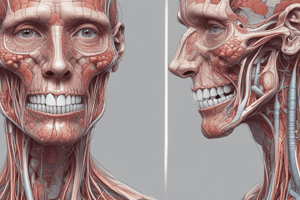Podcast
Questions and Answers
Match the following bones or structures with their descriptions:
Match the following bones or structures with their descriptions:
Hyoid = Horseshoe-shaped bone for tongue attachment Sphenoid = Butterfly-shaped bone at the base of the skull Mandible = Lower jawbone Vomer = Bone forming part of the nasal septum
Match the major salivary glands with their size:
Match the major salivary glands with their size:
Submandibular = Second largest salivary gland Sublingual = Smallest major salivary gland Parotid = Largest salivary gland Submaxillary = Another name for the submandibular gland
Match the names with the correct ducts:
Match the names with the correct ducts:
Duct of Rivinus = Minor salivary duct von Ebner's salivary gland = Associated with the taste buds Wharton's duct = Submandibular duct Stensen's duct = Parotid duct
Match the arteries with their descriptions:
Match the arteries with their descriptions:
Match the artery with its function:
Match the artery with its function:
Match the landmarks of the face with their descriptions:
Match the landmarks of the face with their descriptions:
Match the landmarks of the oral cavity with their descriptions:
Match the landmarks of the oral cavity with their descriptions:
Match the structures found in the vestibular region:
Match the structures found in the vestibular region:
Match the characteristics of normal gingival tissue:
Match the characteristics of normal gingival tissue:
Match the following regions or structures to their corresponding descriptions:
Match the following regions or structures to their corresponding descriptions:
Match the types of gingiva to their definitions:
Match the types of gingiva to their definitions:
Match the cranial bones to their descriptions:
Match the cranial bones to their descriptions:
Match the types of tissue or membranes to their locations:
Match the types of tissue or membranes to their locations:
Match the following oral cavity regions or structures with their counterparts:
Match the following oral cavity regions or structures with their counterparts:
Match the cranial nerve with its function:
Match the cranial nerve with its function:
Match the features concerning temporomandibular disorder (TMD):
Match the features concerning temporomandibular disorder (TMD):
Match the maxillary region structures to their terms:
Match the maxillary region structures to their terms:
Match the oral cavity components to their respective categories:
Match the oral cavity components to their respective categories:
Match the terms related to the head regions with their definitions:
Match the terms related to the head regions with their definitions:
Match the following functions to the relevant body parts or structures:
Match the following functions to the relevant body parts or structures:
Match the following terms to their definitions:
Match the following terms to their definitions:
Match the following glands to their characteristics:
Match the following glands to their characteristics:
Match the functions to their associated symptoms:
Match the functions to their associated symptoms:
Match the following types of movement with the TMJ:
Match the following types of movement with the TMJ:
Match these body parts with their associated characteristics:
Match these body parts with their associated characteristics:
Match the following structures to their corresponding glands:
Match the following structures to their corresponding glands:
Match the sensory functions with their respective organs:
Match the sensory functions with their respective organs:
Match these cranial nerves with their primary functions:
Match these cranial nerves with their primary functions:
Match the following locations with their descriptions:
Match the following locations with their descriptions:
Match the following teeth characteristics with gender:
Match the following teeth characteristics with gender:
Match the following bones with their function:
Match the following bones with their function:
Match the following regions of the head:
Match the following regions of the head:
Match the following terms related to the tongue:
Match the following terms related to the tongue:
Match the following anatomical terms with their definitions:
Match the following anatomical terms with their definitions:
Match the following terms with their anatomical references:
Match the following terms with their anatomical references:
Match the following types of gingiva with their descriptions:
Match the following types of gingiva with their descriptions:
Match the following terms related to gingiva:
Match the following terms related to gingiva:
Match the following structures with their descriptions:
Match the following structures with their descriptions:
Match the regions of the oral cavity with their descriptions:
Match the regions of the oral cavity with their descriptions:
Match the body systems with their functions:
Match the body systems with their functions:
Match the organization levels of the human body from simplest to most complex:
Match the organization levels of the human body from simplest to most complex:
Match the types of tissue with their primary locations:
Match the types of tissue with their primary locations:
Match the types of cavities with their definitions:
Match the types of cavities with their definitions:
Study Notes
Facial Anatomy and Salivary Glands
- Hyoid Bone: Horseshoe-shaped bone where tongue and floor of mouth muscles attach.
- Largest Major Salivary Gland: Parotid gland.
- Parotid Duct: Also known as Stensen's duct.
Arteries of the Oral Region
- Artery Behind the Ramus: Inferior alveolar artery with five branches.
- Supplies Maxillary Molars and Premolars: Posterior superior alveolar artery.
Landmarks of the Face
- Key Facial Features: Eyes, ears, nose, forehead, chin, cheeks, lips.
Landmarks of the Oral Cavity
- Oral Cavity Components: Lips, teeth, hard palate, soft palate, tongue, gingiva.
Vestibular Region of the Oral Cavity
- Structures Present: Lips, cheeks, gingiva, vestibule.
Oral Cavity Proper
- Definition: Space within the dental arches, bordered by hard/soft palate, tongue, and the floor of the mouth.
Characteristics of Healthy Gingiva
- Normal Appearance: Firm, pink, stippled texture.
Regions of the Face
- Forehead: Extends from eyebrows to hairline.
- Vermilion Border: Line marking color change from face to lips.
Tissue Types in Oral Cavity
- Covers Oral Cavity: Stratified squamous epithelium.
Types of Upper Jaw Bones
- Maxilla: Forms the upper jaw and hard palate.
- Zygomatic Bones: Form the cheeks.
Unique Skull Features
- Movable Skull Bone: Mandible.
- Mental Foramen: Located on the mandible.
Symptoms of TMJ Disorder
- Common Signs: Ear pain, headaches, jaw clicking.
Taste Buds Functions
- Primary Role: Identify sweet, salty, sour, and bitter flavors.
Major Organs of the Body
- Organ Systems: Include skeletal, muscular, nervous, respiratory, circulatory, digestive, urinary, reproductive, endocrine, lymphatic, and integumentary.
Basic Body Organization
- Levels of Organization: Cells, tissues, organs, systems.
Genetic Information Carriers
- Cell Structure: Nucleus contains genetic material.
Muscles and Gums Terminology
- Gums: Anatomically referred to as gingiva.
- Unattached Gingiva: Also known as free or marginal gingiva.
- Interdental Gingiva: Known as interdental papilla.
Oral Structures
- Frenulum: Fold of tissue extending from floor of the mouth to the underside of the tongue.
- Uvula: Hanging tissue at the soft palate's border.
Anatomical Terms
- Dorsum: Upper surface of the tongue.
- Labial Frenum: Structure connecting oral mucosa to facial midline of mandibular arch.
Vitamin Deficiency Effects
- Inflamed Areas: Labial commissures may be affected by vitamin B deficiency.
Body Cavities
- Major Cavities: Dorsal and ventral.
Organization of Living Systems
- Levels of Life Complexity: Cells are the simplest unit, organs are more complex, followed by systems.
Studying That Suits You
Use AI to generate personalized quizzes and flashcards to suit your learning preferences.
Related Documents
Description
Test your knowledge on the anatomy of salivary glands and important bones in the oral cavity. This quiz covers key concepts such as the hyoid bone, major salivary glands, and the anatomy of related ducts. Perfect for students in anatomy or dental courses.




